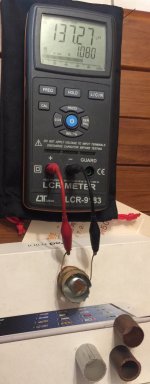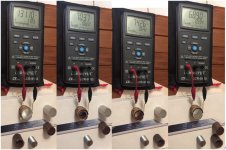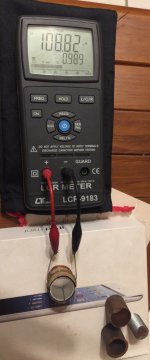Could be. It is coincidental that when I was playing around with a voice coil from a torn down driver, I stuck an aluminum tube down the middle and the inductance at 10KHz was lower than when using a thicker copper tube. It gave me a surprise.
So I was wondering why didn’t more manufacturers use it instead?
This is what I could not figure out.
The effectiveness of a shorting ring depends on its total resistance - lower is better. Silver has the lowest resistivity, so for a given cross section it will work best. Copper is next and then aluminium. But if we can change the cross sectional area then we can make them all the same, just need more metal for aluminium than copper then silver.
YES. So My thought was, were they using aluminum to manipulate the "effectiveness"? What freq range is effected by these rings? Do they effect low freq damping?
Nobody has mentioned the ULTRA LOW DISTORTION series of drivers from BMS like 5S117,6S117, 8S215, 8S219,12S320,15S320 to name a few. These all have triple aluminum demodulation rings, so why don't these seem to get much attention in the forums? They are one of the few manufacturers to actually publish distortion measurements.
Their woofers have impressive measurements. The 18N862 performed very well under extreme power tests done by Data-Bass. My next project will include two 15N850v2's.
YES. So My thought was, were they using aluminum to manipulate the "effectiveness"? What freq range is effected by these rings? Do they effect low freq damping?
The idea of the rings is to cut down on the modulation of the gap flux by the voice coil current. This would mostly be a problem of modulation of the higher frequencies by lower ones, but it is a broadband problem, unlike displacement related nonlinearity with is basically only a LF problem. These rings would have only a very small (if any) effect on the LF damping of the driver.
That's an interesting effect. Not what I would have expected.
The only thing that I can think is that the different material change the magnetic permeability of the core. For example we know that if we increase this permeability with steel that the inductance goes up. Perhaps these metals are lowering the permeability somehow.
Maybe a shorting ring does lower the inductance. Not sure about either of these however.
To the extent there is coupled flux, it makes an air-core transformer with a shorted secondary. Some of the inductance of the secondary would be reflected to the primary.
Aluminum is a little paramagnetic too. Haven't checked the other materials.
Can't tell what everything is sitting on. Especially if steel, it might have some effect on things.
Aluminum is a little paramagnetic too. Haven't checked the other materials.
Can't tell what everything is sitting on. Especially if steel, it might have some effect on things.
I get it, the two inductors are in parallel.
But here is what I don't understand, the higher the resistivity of the shorting turn the lower the inductance appears to go. By that logic an infinite shorting turn resistance should lower the inductance to zero. How do you explain that?
But here is what I don't understand, the higher the resistivity of the shorting turn the lower the inductance appears to go. By that logic an infinite shorting turn resistance should lower the inductance to zero. How do you explain that?
The effective resistance of the shorting secondary turn is equivalent to a lumped resistor in series with its leakage inductance, all of which is in parallel with the inductance due to flux shared between primary and secondary (considerations subject as appropriate to scaling according to turns ratio).
In the transformer equivalent model, if the secondary is shorted then only leakage inductance is reflected back to the primary (neglecting any capacitance). If the secondary is open, then no current flows in the secondary and nothing to reflect back to the primary.
Are we in agreement that far?
In the transformer equivalent model, if the secondary is shorted then only leakage inductance is reflected back to the primary (neglecting any capacitance). If the secondary is open, then no current flows in the secondary and nothing to reflect back to the primary.
Are we in agreement that far?
Last edited:
From the left, the first is the inductance of just a voice coil, the second has a copper ring insert, the third has a thinner copper ring insert, the forth as an aluminum ring insert.
Below, I added an iron core which was cut off from a screw into the center of the aluminum ring.

Below is just the iron core inserted alone.

Last edited:
That's an interesting effect. Not what I would have expected.
The only thing that I can think is that the different material change the magnetic permeability of the core. For example we know that if we increase this permeability with steel that the inductance goes up. Perhaps these metals are lowering the permeability somehow.
Maybe a shorting ring does lower the inductance. Not sure about either of these however.
Yes, the shorting ring does lower inductance. I am going to take some time to look at the impedance curves of just the voice coil. Lots of literature indicating shorting rings reduce inductance distortion, I also have a driver which the manufacturer added a shorting ring into the design and lifted the response of the higher frequencies. I was exploring ring thickness and material effects. Seems aluminum reduces inductance more.
The idea came from a different thread which mentioned an Audio Precision filter for testing class D amps used an aluminum shield to block external metals from influencing the inductor performance. But I also wondered why most use copper shorting rings. Since BMS uses aluminum, I guess it should be a good material to use.
Sorry, just back.
Ok, sure I can see that thus far.
So, if we have conducting cylinder as a secondary, and it's resistivity is low, mostly what happens is we have it's leakage inductance in parallel with the primary magnetizing inductance, and both of those in series with the primary leakage inductance. So inductance seen from the primary terminals drops. This is about the same as having shorted secondary in any transformer, the inductance as seen from the primary terminals goes down. Is there a problem I am missing?
- Home
- Loudspeakers
- Multi-Way
- Who makes the lowest distortion speaker drivers


